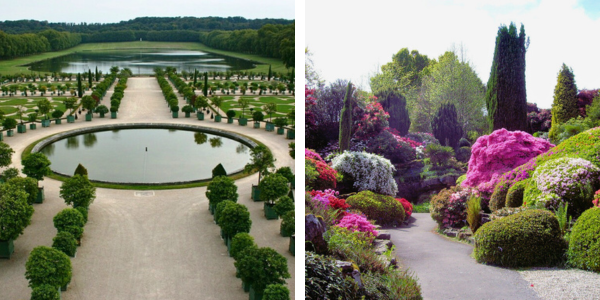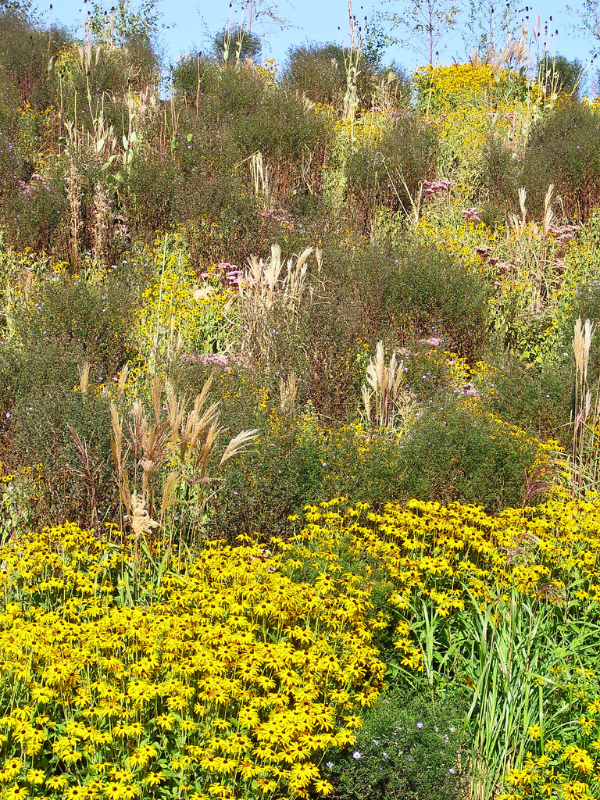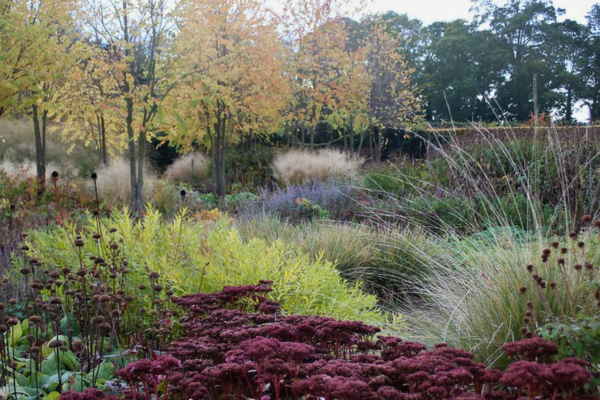Here are some of the key design principles you can apply to your garden.
Balance
Balance in garden design is about how visual weight is distributed across a space. Without it, one side of a garden might feel heavy, while the other feels empty or scattered. Creating balance brings a sense of harmony and stability to a space.
There are two main ways to achieve balance:
- Symmetrical Balance creates harmony by mirroring elements like plant placement, pathways and structures on either side of a central axis. Think of formal European gardens, such as Versailles, where neatly trimmed hedges and flower beds are arranged in a formal and precise manner.
- Asymmetrical Balance relies on visual weight rather than identical sides. It’s often found in naturalized-styled gardens, where plant groupings mimic natural landscapes. For example, a large tree on one side might be balanced on the other side by a grouping of medium-sized shrubs and perennials to create a similar sense of fullness without strict symmetry.
To achieve this kind of balance, consider how plants convey visual weight. Shape, density, fullness, texture and colour intensity all influence whether a plant feels “heavy” or “light” in the landscape. By using these attributes intentionally, you can counterbalance or outweigh bold features like a large tree, boulder or mass of taller grasses.

What to Watch For
- Overloading one side with all the most striking plants can make the space feel unbalanced or disjointed.
- Too much symmetry can feel rigid in naturalized-style gardens.
- Too little structure can make asymmetry feel chaotic instead of intentional.
A helpful test: Step back and squint at your layout. If one side feels too busy or the other too empty, adjust by simplifying where it’s crowded and add mass or form where it’s lacking.
Unity
Unity ties your garden together, creating a quiet sense of belonging and flow. When done well, each element feels like part of the same conversation rather than a competition for attention.
There are two main ways to achieve unity:
- Repetition is the reappearance of a specific element - a plant, a shape, a texture or a colour throughout a space.
- Rhythm is how those repeated elements are spaced or arranged across the space. It creates visual flow, guiding your eye from one area to the next.
Repetition and rhythm are common in natural landscapes: goldenrod blooming in soft waves, or silver groundcovers threading through a woodland edge. These loose patterns help tie the space together.

What to Watch For
- Repeat small drifts of three to seven plants with similar colour or texture to create subtle links across the garden.
- Choose a few anchor plants with strong presence, such as wild bergamot, switchgrass or a bold shrub like ninebark, and echo them in different areas.
- Use the same mulch, pathway material or groundcover throughout to help tie separate beds together.
Caution: Too much repetition can lead to monotony or even monoculture (a single plant species over a large area). Repeating a single species across large areas reduces biodiversity and seasonal interest, making the garden more vulnerable to pests and disease. Aim for a mix of native plants with similar forms or colours to maintain both cohesion and ecological health.
Emphasis
Emphasis gives a garden structure by drawing attention to one or two standout features, like a flowering tree, a water feature or a boulder. These focal points act as visual anchors, offering a place for the eye to pause. A focal point doesn’t work in isolation. What surrounds it matters just as much as the feature itself.
Supporting elements can come through:
- Placement: Situate focal points at the end of a path, along a curve or in line with a natural view. These subtle cues create a sense of arrival and help ground the feature in the space.
- Framing: Use low-growing or finer-textured plants, repeated shapes or open spaces to guide attention toward the focal point. Framing gives focal points breathing room so it can stand out without being overwhelmed.
- Contrast: Position your focal point near plants with opposing qualities, like an upright form beside a low mound or dark foliage set against something lighter. These quiet opposites create visual tension that draws the eye and sharpens definition within the overall design.
Caution: Too many focal points can compete for attention. One or two per space is usually enough, especially when they’re well-placed and well-supported.
Diversity
Diversity adds depth, resilience and long-term interest to a garden. It includes variation in colour, height, texture, form and seasonal expression.
Aim for variety in:
- Vertical diversity: Layer plantings to create structure and flow—taller trees or shrubs form the upper canopy, mid-sized shrubs and perennials add density and groundcovers fill gaps and protect soil.
- Seasonality: Plan for interest in all seasons, through blooms, foliage, berries or structure.
- Form and texture: Mix bold, fine, airy, spiky and cascading elements to add depth and dimension.
- Species: Use a range of native plants that support different ecological functions, like providing nectar, seeds, shelter or nesting space.
You’ll find this kind of balanced diversity in natural landscapes, where tall, medium and low-growing plants layered together in shifting layers of texture and colour throughout the year.

Design Tip:
- Include at least three to five bloom periods to support wildlife from early spring through late fall.
- Don’t overlook winter interest. Grasses, seedheads and evergreen plants can bring structure and texture to the garden while providing valuable habitat.
- Balance variety with cohesion. Even in a diverse garden, echoing a few forms, textures or colours helps tie the space together.
Caution:
Avoid visual clutter: A wide variety of plants adds value, but overcrowding can make a garden feel messy. Design diversity works best when each layer and texture has space to be seen and appreciated. Read more about our recommended spacing.
Vary the structure: When most plants in a garden are the same height and form, like medium-sized mounds, the space can lose its sense of layering and visual interest.
Designing a garden is an ongoing process that involves observation, creativity and care. You don’t need to apply every design principle at once. Starting small, staying curious and observing what works can lead to thoughtful growth. Each choice, whether a repeated texture, a framed focal point or a burst of seasonal bloom, contributes to a garden that is both beautiful and ecologically meaningful.
Ready to bring these ideas to life? LEAF’s subsidized Backyard Tree Planting Program offers a range of hardy native trees and shrubs to help you get started. Visit our Homeowners page or explore the Shrubs, Cedars and Pawpaws page to plan your spring planting.
Amba is the Residential Planting Programs Assistant at LEAF.
LEAF offers a subsidized Backyard Tree Planting Program for private property. The program is supported by the City of Toronto, the Regional Municipality of York, the City of Markham, the Town of Newmarket, the Regional Municipality of Durham, the Town of Ajax, the Township of Brock, the Municipality of Clarington, the City of Oshawa, the City of Pickering, the Township of Scugog, the Town of Whitby and Ontario Power Generation.
